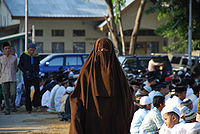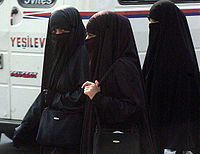Niqāb
From Wikipedia, the free encyclopedia
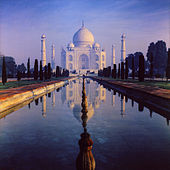 Part of a series on |
|
|---|---|
| Architecture | |
|
Arabic · Azeri |
|
| Art | |
|
Calligraphy · Miniature · Rugs |
|
| Dance | |
| Dress | |
|
Abaya · Agal · Boubou |
|
| Holidays | |
|
Ashura · Arba'een · al-Ghadeer |
|
| Literature | |
|
Arabic · Azeri · Bengali |
|
| Islamic Martial Arts | |
| Music | |
| Dastgah · Ghazal · Madih nabawi |
|
| Theatre | |
|
Part of a series on |
|
| Fields | |
A niqāb (Arabic: means "Mask" نِقاب) is a veil which covers the face, worn by some Muslim women as a part of sartorial hijāb. The face-veil, which is believed, in some form, to have originally been part of women's dress among certain classes in the Byzantine Empire and/or pre-Islamic Persia, was adopted into Muslim culture during the Arab conquest of the Middle East.[1] Niqab is most common in the Arab countries of the Persian Gulf such as Saudi Arabia, Yemen, Bahrain, Kuwait, Qatar, Oman, and the UAE. It is also common in Pakistan.
Women who wear the niqāb are often called niqābīah; this word is used both as a noun and as an adjective. However, some prefer the participial form munaqqabah (plural munaqqabāt) as "niqābīah" may be used in a derogatory manner (much as with "hijābīah" versus muhajjabah).[2]
Because of the wide variety of hijab worn in the Muslim world, it can be difficult to definitively distinguish between one type of veil and another. The terms niqāb and burqa are often used interchangeably.[2] Muslim girls are advised by some schools of Islam to wear the niqāb starting at puberty.[3][4]
Contents |
[edit] Niqāb in Islam
[edit] Rationale
The niqāb is regarded differently by the various schools of Islamic jurisprudence (madhāhib).[5] The issue has continued to arouse debate between Muslim scholars and jurists both past and present concerning whether it is fard (obligatory), mustahabb (highly recommended), or forbidden for a woman to wear niqāb.[6] Salafi Muslims believe that a woman's awrah in front of unrelated men is her entire body including her face and hands. [7] [8] [9][10] [11][12] [13] [14] [15]
Salafi women in countries such as Saudi Arabia veil their faces because they believe the face of a woman is considered awrah. Awrah denotes the parts of the body that are not meant to be exposed in public.[16] However, wearing the niqab is not exclusive to Salafi Muslims and some other Muslims whether Shia or Sunni, regard niqab as mustahabb (seeking the love of Allah).[17] [18]
The claimed rationale of the niqāb comes from the Qur'an and Hadith. It was known that the many wives of Muhammad were made to cover their faces whenever around men they did not know, and hence it is claimed that under Islam the niqāb is a requirement for all women, since womanhood is mentioned along with the wives of Muhammad in the Qur'anic dictat to cover.[19] The following verse from the Qur'ān is cited as support for this:[20]
O Prophet, tell your wives and daughters, and the women of the faithful, to draw their wraps over them. They will thus be recognised and no harm will come to them. God is forgiving and kind.[Qur'an 33:59 (Translated by Ahmed Ali)]
The Qur'an makes a few statements about women covering themselves.[3][21] The reasons for the niqāb are to keep Muslim women from worrying about their appearances and to conceal their looks.[20][22]
[edit] Hadith
The hadith (Arabic plural:ahādīth) are narrations supposedly originating from the words and deeds of the Islamic prophet Muhammad. They are traditions and are therefore not quotes from the Qur'an. As with all traditions, it cannot be definitively proved that they are accurate representations of the time.
The Arabic word jilbāb is used in the following traditions:
- Narrated Aisha (part of a much longer narration): "...When he reached my place in the morning, he saw the figure of a sleeping person and he recognized me on seeing me as he had seen me before the order of compulsory veiling (was prescribed). So I woke up when he recited Istirja' (i.e. "Inna lillahi wa inna llaihi raji'un") as soon as he recognized me. I veiled my face with my head cover at once, and by Allah, we did not speak a single word, and I did not hear him saying any word besides his Istirja'. (Volume: 5, Book Number: 59, Hadith Number: 462)
- Narrated Aisha: The woman is to bring down her Jilbāb from over her head and [then place it] upon her face. {Bukhari:6:60:282}, {Sunnan Abu Dawud 32:4091}
- Narrated Aisha: The riders used to pass by us when we were with the Messenger of Allaah in ihrām When they came near, each of us would lower her Jilbāb from her head over her face, and when they passed by we would uncover our faces. Sunnan Abu Dawud 1:1833
- Narrated Aisha: Safwaan ibn al-Mu’attal al-Sulami al Dhakwaani was lagging behind the army. She said, “He came to where I had stopped and saw the black shape of a person sleeping. He recognized me when he saw me, because he had seen me before Hijāb was enjoined. I woke up when I heard him saying ‘Inna Lillaahi wa inna ilayhi raaji’oon (verily to Allaah we belong and unto Him is our return),’ and I covered my face with my Jilbāb Sahih Muslim 2:2770
- Narrated‘Aasim al-Ahwal: We used to enter upon Hafsah bint Sirīn who had put her Jilbāb thus and covered her face with it, and we would say to her: May Allah have mercy on you. Allaah says (interpretation of the meaning): “And as for women past childbearing who do not expect wedlock, it is no sin on them if they discard their (outer) clothing in such a way as not to show their adornment” [al-Noor 24:60]. And she would say to us: What comes after that (of the āyah)? We would say: “But to refrain (i.e. not to discard their outer clothing) is better for them”. And so she said: [Referring to, ‘But to refrain is better for them’], “It is to keep the Jilbāb.” Sahih al-Bukhari 3:311:1
- Narrated Ibn ‘Abbās: Allah commanded the believing women, when going out of their homes for some need, to cover their faces from above their heads with their Jilbābs, leaving one eye(or both) to see the path.[23]
- From Asmā’ bint Abi Bakr, that she said, “We are used to cover our faces from the men, and cut our hair before that in Ihrām (for Hajj).[24]
- From Asmā’ bint Abi Bakr, We would cover our faces while we were Muhrim, and while doing that we would be with Asmā’ bint Abi Bakr As-Siddeeq.[25]
- From Ibn Abi Khaythamah, We entered upon Umm Al-Mu’minīn on Yawm At-Tarwayah and we said to her, ‘Oh Mother of the Believers! Here is a woman who refuses to cover her face and she is a Muhrimah (in ihrām). So ‘Aa’ishah lifted her Khimār from her chest, and covered the woman’s face with it.[26]
- Narrated Aisha: "When (the Verse): "They should draw their veils over their Juyubihinna," was revealed, (the ladies) cut their waist sheets at the edges and covered their faces with the cut pieces. Sahih al-Bukhari 60:282:1
- Narrated 'Aisha: The Apostle of Allah used to offer the Fajr prayer and some believing women covered with their veiling sheets used to attend the Fajr prayer with him and then they would return to their homes unrecognized Sahih al-Bukhari 8:368:1
- Narrated Um 'Atiya: We were ordered the Apostle of Allah to bring out our menstruating women and veiled women in the religious gatherings and invocation of Muslims on the two 'Eid festivals. These menstruating women were to keep away from their Musalla. A woman asked, "O Allah's Apostle ' What about one who does not have a niqab?" He said, "Let her share the veil of her companion." Sahih al-Bukhari 8:347:1
- From Anas that the Messenger of Allah said: And if one of the women of Paradise looked at the earth, she would fill the whole space between them the earth and the heaven with light, and would fill whatever is in between them, with perfume, and the veil of her face is better than the whole world and whatever is in it."Sahih al-Bukhari 8:572:1
- Narrated Thabit ibn Qays : A woman called Umm Khallad came to the Prophet while she was veiled. She was searching for her son who had been killed in the battle. Some of the Companions of the Prophet said to her: You have come here asking for your son while veiling your face? She said: If I am afflicted with the loss of my son, I shall not suffer the loss of my modesty. The Apostle of Allah said: You will get the reward of two martyrs for your son. She asked: Why is that so, oh Prophet of Allah? He replied: Because the people of the Book have killed him."Sahih al-Bukhari 14:2482:1
- All of a woman is awrah. Whenever she leaves her home Satan reachs by her."Sunnan Abu Dawud 2:311
- A woman called Umm Khallad came to the Prophet while she was veiled. She was searching for her son who had been killed in the battle. Some of the Companions of the Prophet said to her: You have come here asking for your son while veiling your face? She said: If I am afflicted with the loss of my son, I shall not suffer the loss of my modesty. The Apostle of Allah said: You will get the reward of two martyrs for your son. She asked: Why is that so, Apostle of Allah? He replied: Because the people of the Book have killed him. (Book Number: 14, Hadith Number: 2482) If she was wrong in her understanding, Muhammad would have corrected her.
[edit] Styles
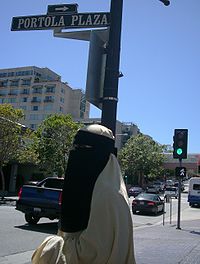
There are many styles of niqāb and other facial veils worn by Muslim women around the world. The two most common forms are the half niqāb and the gulf-style or full niqāb.
The half niqāb is a simple length of fabric with elastic or ties and is worn around the face. This garment typically leaves the eyes and part of the forehead visible.
The gulf-style or full niqāb completely covers the face. It consists of an upper band that is tied around the forehead, together with a long wide piece of fabric which covers the face, leaving an opening for the eyes. Many full niqāb have two or more sheer layers attached to the upper band, which can be worn flipped down to cover the eyes or left over the top of the head. Contrary to common belief, eyeveils do not generally restrict vision any more than a dark pair of sunglasses would. While a person looking at a woman wearing a niqāb with an eyeveil would not be able to see her eyes, the woman wearing the niqāb would be able to see out through the thin fabric.
Other less common and more cultural or national forms of niqāb include the Afghani style burqa, a long pleated gown that extends from the head to the feet with a small crocheted grille over the face.[2]. The Pak Chador, a relatively new style from Pakistan, which consists of a large triangular scarf with two additional pieces.[2] A thin band on one edge is tied behind the head so as to keep the chador on, and then another larger rectangular piece is attached to one end of the triangle and is worn over the face, and the simple hijāb wrapped, pinned or tied in a certain way so as to cover the wearer's face.
Other common styles of clothing popularly worn with a niqāb in Western countries include the khimar, a semi-circular flare of fabric with an opening for the face and a small triangular underscarf. A khimar is usually bust-level or longer, and can also be worn without the niqāb. It is considered a fairly easy form of headscarf to wear, as there are no pins or fasteners; it is simply pulled over the head. Gloves are also sometimes worn with the niqab, because many munaqabāt believe no part of the skin should be visible other than the area immediately around the eyes or because they do not want to be put in a position where they would touch the hand of an unrelated man (for instance, when accepting change from a cashier).
Most munaqabāt also wear an overgarment (jilbab, abaya etc.) over their clothing, though some munaqabat in Western countries wear a long, loose tunic and skirt instead of a one-piece overgarment.
[edit] In different countries

[edit] Iran
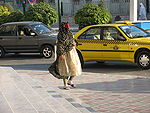
The Niqab was traditionally worn in Iran from the arrival of Islam until the end of the Qajar era. There were many regional variations of Niqāb, which were also called Ruband or Pushiye.
The 20th century ruler, Reza Shah, banned all variations of face veil in 1936, as incompatible with his modernistic ambitions. Reza Shah ordered the police to arrest women who wore the niqāb and to remove their face veils by force. This policy outraged the clerics who believed it was obligatory for women to cover their faces. Many women gathered at the Goharshad Mosque in Mashhad with their faces covered to show their objection to the niqāb ban.[27]
Between 1941 and 1979 wearing the niqāb was no longer against the law, but it was considered by the government to be a “badge of backwardness." During these years, wearing the niqāb and chador became much less common and instead most religious women wore headscarves only. Fashionable hotels and restaurants refused to admit women wearing niqābs. High schools and universities actively discouraged or even banned the niqāb, though the headscarf was tolerated.[28]
After the new government of Islamic Republic was established, the niqāb was not enforced by officials.
In modern Iran, the wearing of niqāb is not common, except in religious cities such as Qom, Mashhad, Kashan and Yazd, in which still many women continue to wear the niqāb. Also in cities of Khuzestan provice women still wear niqab. The Bandari ‘Arabs traditionally wear niqāb. They have the traditional style which is similar to the traditional veil worn in Qatar and UAE and a similar style of dressing. They normally wear a chador over the niqāb and wrap it around themselves. They have a very unique way of dressing that is not worn by any other ethnic group in Iran.[citation needed]
[edit] Saudi Arabia
Saudi women are required both by law and tradition to wear the niqāb in cities such as Mecca, Medina and Taif. In other cities such as Dammam and Abha, as well as southern cities, women are not required to wear it by law, yet most women observe niqāb and it remains de facto obligatory. Women may be harassed by the religious police if they do not cover their faces. Jeddah, as the most liberal city of Saudi Arabia, is an exception.
The Saudi niqāb usually leaves a long open slot for the eyes; the slot is held together by a string or narrow strip of cloth.[29] Many also have two or more sheer layers attached to the upper band, which can be worn flipped down to cover the eyes. Although a person looking at a woman wearing a niqāb with an eyeveil would not be able to see her eyes, she would still be able to see out through the thin fabric. In 2008, the religious authority in Mecca, Mohammad Habadan called on women to wear veils that reveal only one eye, so that women would not be encouraged to use eye make-up.[30]
According to Saudi Arabia's Shariah law, women's clothing should meet the following conditions:
- Women must cover their entire body, but they are allowed to expose one or both eyes in necessity.
- Women should wear abaya and niqāb thick enough to conceal what is underneath, and the abaya should be loose-fitting.
- Women should not wear brightly coloured clothes or clothes that are adorned so that they may attract men's attention.[31]
[edit] Yemen
Since antiquity, the Arab tradition of wearing the niqāb has been practiced by women living in Yemen.[32] Traditionally, girls begin wearing veils in their teenage years.[33] [34]
[edit] Enforcement, encouragement and bans
[edit] Enforcement
Covering the face was enforced by the Taliban regime, however the burqa was the most common covering among Afghan women.[35] While some women wholeheartedly embraced the rules, others protested.
Non-governmental enforcement of niqab is found in many parts of the Muslim world. In Saudi Arabia, all Saudi Muslim women are required to wear the niqab in cities such as Mecca, Medina and Taif. In other cities such as Dammam and Abha, women are not required to wear it by law but it remains de facto obligatory. In southern cities also, most women observe niqab. The Saudi niqāb usually leaves a long open slot for the eyes; the slot is held together by a string or narrow strip of cloth. In 2008, the religious authority in Mecca, Mohammad Habadan called on women to wear veils that reveals only one eye, so that women would not be encouraged to use eye makeup.[36]
[edit] Politics
The niqāb has had a significant role for women in the West Bank during the Israeli-Palestinian conflict. Many Palestinian women, especially students, have worn white niqābs during protests against Israel's actions.[37][38] These women often wear green banners with Arabic messages in them. Female candidates from the Hamas party in the 2006 Palestinian parliamentary elections campaigned in niqābs, even in photographs. Since Hamas took over Gaza strip during the Battle of Gaza (2007) women are wearing Niqab in large numbers.[39].[40]
Sultaana Freeman gained national attention in 2003 when she sued the U.S. state of Florida for the right to wear a niqāb for her driver's license photo.[41] However, a Florida appellate court ruled that there was no violation in the state requiring her to show her face to a camera in a private room with only a female employee to take the picture, in exchange for the privilege of driving.
In 2005, a non-Muslim student at Eastern Michigan University spent a semester wearing a niqāb for a class project (she referred to the face veil as a 'burqa,' a term which can be used to describe both the full, "gulf-style" niqab she wore and the Afghani style head-to-toe garment). Her experiences, such as feeling like no one wanted to be near her, led her to conclude that conservative Muslim dress is disapproved of in the United States.[42]
The niqāb is outlawed in the Muslim country of Tunisia. In Turkey, where the overwhelming majority of the population is Muslim, the traditional womenswear in cities at the turn of the twentieth century was called çarşaf (an outer garment similar to the Iranian chador) which would be accompanied by a piece of semi-transparent clothing to cover the lower face, called peçe. Although this combination is still being worn in some localities, the practice of covering the face has largely died off. In Turkey today, niqabi women, just like women wearing hijab, cannot work as public servants, neither can they continue studies at schools, including the private schools. Although there is no single law banning niqab at private companies, it would be nearly impossible for a niqabi woman to find work.
In February 2010, an Arab country's ambassador to Dubai had his marriage annulled after discovering that his bride was cross-eyed and had facial hair. The woman had worn a niqab on the occasions that the couple had met prior to the wedding. The ambassador informed the Sharia court that he had been deliberately deceived by the bride's mother, who had shown him photographs of the bride's sister. He only discovered the problem when he lifted the niqab to kiss his bride. The court annulled the marriage, but refused a claim for compensation.[43][44][45]
[edit] Europe
Although the burqa is a more emphatic symbol, the niqāb has also been prominent in political controversies on Islamic dress in Europe. The Netherlands government plans a legal ban on face-covering Islamic clothing, popularly described as the 'burqa ban', which includes the niqāb.[46]
In the United Kingdom, comments by Jack Straw, MP started a national debate over the wearing of the "veil" (niqāb), in October 2006. This was further inflamed by extensive media coverage of the case of Aishah Azmi, a teaching assistant in Dewsbury, West Yorkshire, who lost her appeal against suspension from her job for wearing the niqāb while teaching English to young children whose first language is different. It was decided that being unable to see her face prevented the children from learning effectively. Azmi argued that it was helping the children understand different people's beliefs.[47]
[edit] North America
[edit] United States
The niqab in its extreme forms is uncommon in the US.[48] In 2002, Sultaana Freeman, (aka Sandra Keller, who converted to Islam in 1997 when marrying a Muslim man) sued the U.S. state of Florida for the right to wear a niqāb for her driver's license photo.[41] However, a Florida appellate court ruled that there was no violation in the state requiring her to show her face to a camera in a private room with only a female employee to take the picture, in exchange for the privilege of driving. The prevailing view is currently that hiding one's face on a form of photo identification defeats the purpose of having the picture taken.[49]
[edit] Canada
Elections Canada, an independent agency responsible for elections and referendums, stated that Muslim women can cover their faces while voting. The decision was criticized by Conservatives, Liberals and the Bloc Québécois. The New Democrats did not oppose this decision.[50]
More recently the Conservative Government has introduced legislation which would bar Muslim women from voting if they show up at polling stations with a veiled face. This law was proposed in the wake of the Government's recent dispute with Elections Canada, which has refused to bar people with veiled faces from polling places.[51]
The niqāb became an issue in the 2007 election in Quebec after it became public knowledge that women wearing the niqāb were allowed to vote under the same rules as electors who did not present photo ID, namely, by sworn oath in the presence of a third party who could vouch for their identity. The chief electoral officer received an overwhelming number of complaints that this policy was too accommodating of cultural minorities (a major theme in the election), and had to be accompanied by bodyguards due to death threats. All three major political parties were against the policy, with the Parti Québécois and Action démocratique du Québec vying for position as most opposed. The policy was soon changed to require all voters to show their face, even if they did not carry photo ID. However, Quebec residents who wear the niqāb stated that they had no issue with showing their faces for official purposes, such as voting.[52] Salam Elmenyawi of the Muslim Council of Montreal estimated that only 10 to 15 Muslim voters in all of the province wear the niqāb, and that since their veils have become controversial, most would probably not vote due to threats and concern for their safety.[53]
In October 2009, the Muslim Canadian Congress called for a ban on burqa and niqāb (though not the hijab), saying that they have "no basis in Islam."[54] Spokesperson Farzana Hassan cited public safety issues, such as identity concealment, as well as gender equality, stating that wearing the burqa and niqāb is "a practice that marginalizes women."[54]
[edit] See also
[edit] References
- ^ See for instance F.R.C. Bagley, "Introduction", in B. Spuler, A History of the Muslim World. The Age of the Caliphs, 1995, X, but also T. Dawson, "Propriety, practicality and pleasure : the parameters of women's dress in Byzantium, A.D. 1000-1200", in L. Garland (ed.), Byzantine women: varieties of experience 800-1200, 2006, 41-76.
- ^ a b c d How to Hijab: Face Veils Modern Muslima and Saraji Umm Zaid Retrieved 16 April 2007.
- ^ a b Niqab According to Quran and Sunnah Muttaqun Online. Retrieved 14 April 2007.
- ^ Taiz Bureau (March 7, 2008). "Girls’ niqāb assassinates their childhood, forces them toward early womanhood.". Yemeni Times. http://www.yementimes.com/article.shtml?i=1184&p=report&a=1. Retrieved 2008-06-02.
- ^ Sanders, Eli. Interpreting veils: Meanings have changed with politics, history. The Seattle Times. 27 May 2003. Web. 30 Oct. 2009.
- ^ Blomfield, Adrian (October 5, 2009). "Egypt purges niqab from schools and colleges". The Telegraph. http://www.telegraph.co.uk/news/worldnews/africaandindianocean/egypt/6262819/Egypt-purges-niqab-from-schools-and-colleges.html. Retrieved October 6, 2009.
- ^ Mohammad Nasir (March 23, 2007). "In Defense of The Obligation of Niqab". Seeking Ilm. http://seekingilm.com/archives/44. Retrieved 2008-06-02.
- ^ Al-Mutaqqun (March 7, 2008). "Revelation of Al-Hijab". Mutaqqun. http://muttaqun.com/niqab.html. Retrieved 2008-06-02.
- ^ Fiqhus Sunnah
- ^ [1]
- ^ Niqāb - Introduction BBC - Religion and Ethics. 16 October 2003. Retrieved 14 April 2007.
- ^ Matter of Choice BBC - Religion and Ethics. 16 October 2003. Retrieved 14 April 2007.
- ^ Hillel Zain (March 7, 2008). "Awrah". Mutaqqun. http://www.scribd.com/doc/14714030/AwRah. Retrieved 2008-06-02.
- ^ Hillel Zain (March 7, 2008). "Guide to Hijab". Salimin. http://www.scribd.com/doc/14705920/Guide-to-Hi-Jab-1. Retrieved 2008-06-02.
- ^ Abdullah Atif Samih (March 7, 2008). "What is Awrah?". Mutaqqun. http://www.scribd.com/doc/12861795/What-is-Awrah. Retrieved 2008-06-02.
- ^ Marfuqi, Kitab ul Mar'ah fil Ahkam, pg 133
- ^ "Understanding the Face Veil". Muhajjaba. March 7, 2008. http://www.muhajabah.com/faceveil.htm. Retrieved 2008-06-02.
- ^ "Why Wear Niqab?". Muhajjaba. March 7, 2008. http://www.muhajabah.com/whyniqab.htm. Retrieved 2008-06-02.
- ^ The Case for Niqab BBC - Religion and Ethics. 16 October 2003. Retrieved 14 April 2007.
- ^ a b Why Women Should Wear the Veil Jamiatul Ulama (KwaZulu-Natal) - Council of Muslim Theologians. 2 August 2001. Retrieved 14 April 2007.
- ^ Niqab in Light of the Quran and Hadith Ibn Farooq. Retrieved 14 April 2007.
- ^ Ruling on covering the face, with detailed evidence
- ^ Tafsīr At-Tabari|2|123
- ^ Ibn Khuzaymah |4|203
- ^ Imām Maalik Muwatta’ |3|217
- ^ At-Talkhees Al-Habeer of Ibn Hajr Al-’Asqalaani |2|272
- ^ Asnad e Kashf e Hijab 24:2
- ^ El-Guindi, Fadwa, Veil: Modesty, Privacy, and Resistance, Berg, 1999
- ^ Moqtasami (1979), pp. 41-44
- ^ "Saudi cleric favours one-eye veil". BBC. 3 October 2008. http://news.bbc.co.uk/2/hi/middle_east/7651231.stm. Retrieved 2008-06-02.
- ^ [The niqab: Between veneration and tradition "The Niqab between veneration and tradition"]. Islam Q&A. 3 October 2008. The niqab: Between veneration and tradition. Retrieved 2008-06-02.
- ^ Ridhwan Al-Saqqaf and Mariam Saleh Aden Bureau (3 October 2008). "Saudi cleric favours one-eye veil". Yemeni Times. http://www.yementimes.com/article.shtml?i=1140&p=report&a=2. Retrieved 2008-06-02.
- ^ Ridhwan Al-Saqqaf and Mariam Saleh Aden Bureau (3 October 2008). "Girls’ niqab". Yemeni Times. http://www.yementimes.com/article.shtml?i=1184&p=report&a=1. Retrieved 2008-06-02.
- ^ Ridhwan Al-Saqqaf and Mariam Saleh Aden Bureau (3 October 2008). "The niqab through a foreigner’s eyes". Yemeni Times. http://yementimes.com/article.shtml?i=1126&p=lastpage&a=1. Retrieved 2008-06-02.
- ^ M. J. Gohari (2000). The Taliban: Ascent to Power. Oxford: Oxford University Press, pp. 108-110.
- ^ "Saudi cleric favours one-eye veil". BBC. 3 October 2008. http://news.bbc.co.uk/2/hi/middle_east/7651231.stm. Retrieved 2008-06-02.
- ^ Palestinians Debate Women's Future Under Hamas By Brenda Gazzar. Women's eNews23 April 2006. Retrieved 13 April 2007.
- ^ Islamist women redraw Palestinian debate on rights by Thanassis Cambanis. Boston Globe. Retrieved 13 April 2007.
- ^ Gaza's deadly guardians
- ^ The eyes have it: Muslim women win role in Palestinian body politic by Ed O'Loughlin. The Age. 24 January 2006. Retrieved 13 April 2007.
- ^ Judge: Woman can't cover face on driver's license 10 June 2003. Cnn.com Retrieved 13 April 2007.
- ^ No one wanted to be near me: Student wears burqa throughout winter semester by Kurt Hunt. 18 April 2005. Retrieved 13 April 2007.
- ^ http://news.bbc.co.uk/1/hi/world/middle_east/8508077.stm
- ^ http://www.dailymail.co.uk/news/worldnews/article-1249922/Ambassador-calls-divorce-veil-wearing-bride-reveals-beard-crossed-eyes.html
- ^ http://gulfnews.com/news/gulf/uae/crime/man-claims-fiancee-hid-beard-under-niqab-1.580722
- ^ Dutch Muslims condemn burqa ban BBC News. Retrieved 13 April 2007.
- ^ 'No discrimination' in veil row BBC News. 19 October 2006
- ^ The Diversity of Muslims in the United States: Views as Americans
- ^ CNN.com - Judge: Woman can't cover face on driver's license - Jun. 10, 2003 - (broken link)
- ^ LeBlanc, Daniel. Elections Canada blasted for allowing Muslim women to vote with faces covered. Globe and Mail.
- ^ [2] yahoo news.
- ^ "Muslim women will have to lift veils to vote in Quebec election". 2007-03-23. http://www.cbc.ca/canada/quebecvotes2007/story/2007/03/23/qc-niqab20070323.html.
- ^ "Veiled threats". 2007-03-24. http://www.canada.com/montrealgazette/news/story.html?id=006205d2-dc3b-491a-8839-b59562ba52d1&k=58807.
- ^ a b "Muslim group calls for burka ban". CBC News. 2009-10-08. http://www.cbc.ca/canada/story/2009/10/08/canada-muslim-burka-niqb-ban-government.html. Retrieved 2009-10-08.
Niqaab A Seal On The Debate by Kamillah Khan
[edit] External links
| Wikimedia Commons has media related to: niqab |
| Wikiquote has a collection of quotations related to: niqab |
- In Defense of Niqab in Islamic Law
- Niqab Page
- Religion and Ethics - Beliefs: Niqab, British Broadcasting Corporation (BBC), 13 April 2007.
- Modesty Gowns for Female Patients, BBC, 5 September 2006
- The Veil and the British Male Elite, Social Science Research Network (SSRN)
- The Obligation of Veiling
- Niqab is Not Obligatory
- The Last Straw!
- A dissertation on 'Niqaab- its Islamic ruling and controversy in the West'
- Why the Veil Liberates Women
- Niqab Debate in Egypt: Divided Scholars
|
|||||||||||


